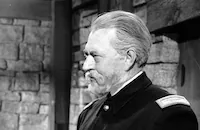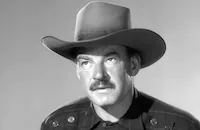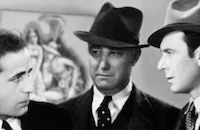The Command

Brief Synopsis
Cast & Crew
David Butler
Guy Madison
Joan Weldon
James Whitmore
Carl Benton Reid
Harvey Lembeck
Film Details
Technical Specs

Synopsis
In Wyoming Territory in 1878, cavalry troop commander Capt. Forsythe is shot by an Indian arrow. Before dying, he transfers his command to non-commissioned officer Dr. Robert MacClaw, ordering him to lead the troop back to their fort. Acknowledging his inexperience with Army protocol, MacClaw encourages the advice of seasoned and reliable Sgt. Elliot, whom Forsythe passed over to succeed him. At first, the dutiful Elliot grudgingly supports the doctor and orders the other soldiers to follow suit, especially a griping trooper, Gottschalk. However, when Elliot realizes that MacClaw listens to him, the two officers form an amiable and respectful alliance. At the next small town are two companies of infantrymen under orders to accompany a civilian wagon train to Paradise River. Believing that their encounter will be brief, Elliot convinces MacClaw to impersonate a captain by wearing Forsythe's stripes, as a rivalry exists between cavalry and infantry, and the death and replacement of their commander by a doctor is an embarrassment to them. As they are just passing through the town, MacClaw agrees to the deception. However, the officer in charge of the infantry, bellowing and officious Col. Janeway, pulls rank and attaches the cavalry unit to his own, as he needs experienced soldiers to support his companies of green recruits through hostile Indian territory. Meanwhile, on the wagon train is Martha Cutting, whose father, a doctor, died at the beginning of the journey west. Martha has been nursing the sick young son of an immigrant Italian family who took her in and is suspicious of the infantry surgeon Trent's diagnosis of grippe. After talking to her, MacClaw, though concealing his medical training, looks for evidence of smallpox. After the convoy leaves town the next day, Indians from a variety of tribes begin a series of raids against them. The ill Janeway, who has been risking his health until he can retire with a pension, is concerned that the Indians' persistence is fueled by news of Indian victory at Little Big Horn. Offering a strategy not found in the Army manual, MacClaw suggests that his men ride behind the convoy, as rear guard, so that they can surprise and overtake attacking Indians. Later, after several families report sickness, Trent sloppily diagnoses smallpox and Janeway quarantines their wagons. Although MacClaw is unconvinced that smallpox is the problem, after revealing to Martha that he is a doctor, he vaccinates her. As they talk, MacClaw admits his plans to return east, where, he suggests, she would be safer, but the doctor's daughter feels useful and believes MacClaw's skills are needed in the West. After Janeway ordes the quarantined wagons to travel far behind the convoy, Martha's Italian family is killed during the next attack. Elliot realizes that the Indians are bolder because they observe the wagon train's weakened condition, so MacClaw devises ways to make the travelers appear stronger. For days, they suffer heat and dust, while Indians try to orce them into a vulnerable defense circle. Thirty miles from Paradise River, the inexperienced infantrymen show signs of stress and Janeway suffers a stroke. While Janeway convalesces, the command falls to a panicking Maj. Gibbs, who recently transferred from a desk in Washington. Gibbs urges MacClaw to take over, so the doctor calls together Gibbs, Elliot, West Point graduate O'Hirons and Sgt. Maj. Jason to strategize. Ten miles ahead is narrow Medford Pass, which they must reach before the Indians. As the wagons cannot outrun their enemy, the officers realize that the Indians expect them to wage a desperate battle on lower ground, which they know they cannot win. Seeing no other workable option, MacClaw proposes an unconventional plan. During the night, while Elliott and twenty soldiers keep Indian scouts away from their camp, MacClaw secretly sends ahead all the civilians in half of the wagons with a contingent of soldiers. He positions the remaining wagons in a circle with a howitzer and sharp shooting riflemen, some dressed as women. The rest of the soldiers hide in the countryside and ambush the attacking Indians. Because of MacClaw's plan, the civilians get safely through the pass, while the soldiers battle the Indians. MacClaw narrowly escapes demise, when a bullet hits a pocket watch belonging to Forsythe, which he had planned to give Elliot. Afterward, examining the dead, MacClaw discovers that the Indians have contracted chicken pox. As the Indians have no built-in immunity to the disease, MacClaw knows they will suffer an epidemic and no longer endanger the wagon train. Upon reuniting with the rest of the convoy, MacClaw confirms that chickenpox, not the dreaded smallpox, has been plaguing the wagon train, but is troubled to learn that Martha intentionally spread the disease to the vulnerable Indians by scattering on the trail colorful clothing worn by the sick. To the recovering Janeway, MacClaw confides his true profession, but the impressed colonel jokes that his battle strategy will soon be in the Army manual. As his term of service has concluded, MacClaw joins Martha on her journey west.

Director
David Butler
Cast

Guy Madison

Joan Weldon

James Whitmore

Carl Benton Reid

Harvey Lembeck

Ray Teal
Bob Nichols
Don Shelton
Zachary Yaconelli
Renata Vanni
Joel Costarella
Tom Monroe
Boyd "red" Morgan

Gregg Barton
Denver Pyle
Jim Bannon
Phil Rich
Wes Hudman
William Vincent
Ronald Shuan
Mack Chandler
Reed Howes
Richard Boyer
Emile Avery
John Gifford
John Berardino
Ken Smith
Bill Wilkerson
Larry Chance

Jack Mower
Crew
Gordon Bau
Wilfrid M. Cline
Ben Corbett
Samuel Fuller
Charles Haefeli
Oren Haglund
Ray Heindorf
Russell Hughes
Stanley Jones
William Kuehl
Moss Mabry
Irene Morra
Phil Quinn
Irva Mae Ross
Ed Scherd
Dimitri Tiomkin
Bertram Tuttle
Robert Wayne
David Weisbart

Film Details
Technical Specs

Quotes
Trivia
Began shooting late July 1953.
Notes
The working title of the film was Rear Guard. According to a November 1949 Variety news item, Warner Bros. bought the novel Rear Guard, which originally appeared in Saturday Evening Post as a serial entitled The White Invader, and planned for it to star Gary Cooper and be produced by Anthony Veiller. However, neither Cooper nor Veiller were involved in the final film. Although a February 1951 Hollywood Reporter news item announced that Stanley Fleischer would serve as art director for the film, only Bertram Tuttle was listed onscreen and Fleischer's contribution to the final film is undetermined.
According to production charts, The Command was initially planned to be filmed in 3-D. Onscreen credits and reviews describe The Command as Warner Bros.' first CinemaScope venture, but the Variety review explains that the film was shot with a Vistarama anamorphic lens and later billed as CinemaScope by agreement with Twentieth Century-Fox. The Los Angeles Times review stated that Warner Bros. subsequently adopted the use of CinemaScope, a type of lens that had so far been used in the shooting of only a handful of films. The film was also the first Western to be billed as CinemaScope. The New York Times reviewer, although lukewarm to what he considered a "standard, bantam-weight" film, was effusive in his description of The Command's use of CinemaScope to depict the "towering magnificence of the natural setting."
The Command marked the final film appearance of cowboy and stunt man Charles Haefeli, who died in February 1955, according to a Hollywood Reporter news item. A modern source adds Kermit Maynard, Chubby Johnson and Iron Eyes Cody to the cast. According to February 1954 news items, the stars of The Command were brought to the Los Angeles premiere at the Paramount Theatre by stagecoach. Later, for a Heart Association fundraiser, lead actor Guy Madison rode the horse Penny, which also appeared in the film, up the steps of City Hall in the style of old Spanish dons at the end of a three-day celebration of the retracing of the El Camino Real.












